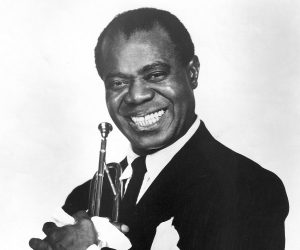Louis Daniel Armstrong, born on August 4th 1901, has always been a staple of 20th century Black music. Growing up, he was constantly referenced as a musician, both a trumpeter, vocalist, as well as composer. His life may have seemed to be glamorous as ever, but he lived his life not without struggles, some struggles that many of us can only pale in comparison to.
Louis Armstrong was abandoned by his father and rarely was ever in contact with his mother during his early years. He primarily raised himself growing up in a ghetto in New Orleans. He survived in those early years by singing on the street corner for tips. When he was 11, he formed his first vocal quartet, this became his source of income for this time. In January 1913, Armstrong was sent to the Colored Waifs Home after firing a gun in public. It was at this home that he joined the school’s band, playing drums. After being a part of the group, he found he was more attracted to horn instruments, so he switched to the trumpet, which is how we primarily know him as today.
During this time he was able to continue his music and get a piece published. His first public work was titled “I Wish I Could Shimmy like My Sister Kate’ which was a moderate success. He continued to grow his musicianship by joining an orchestra, even though he was unable to read music still at this time. He kept up with his composing and began to record Jazz Albums in 1924/1925. Armstrong was able to influence jazz, blues, and rock vocalists alike. Predating rap, his scat style later peaked with the piece “Basin Street Blues.”
Sometime during the 1920’s, Armstrong was introduced to marijuana by white jazz musician Mezz Mezzrow, Armstrong enjoyed smoking it heavily throughout his life, this is one contributor to the calm, cool demeanor that we know him by today. By 1929, Armstrong took a more commercial route, singing more popular tunes and replacing his combo with that of larger orchestras. Armstrong was always much more a featured soloist than a bandleader.
In 1934, Armstrong severely damaged his lips, so while he kept his playing to a minimum, his preference to singing took the centerpiece for his career.
Armstrong was considered an innovator for his styles, predating rap, as well as in the early 1940’s, Armstrong predicted the fall of a larger band style and began to work back to his smaller combos. He was one of the first Black musicians to “Break the Color Barrier” by performing in the largest concert halls all over the world. It is his career that defines him as an important figure.
Armstrong was considered an innovator for his styles, predating rap, as well as in the early 1940’s, Armstrong predicted the fall of a larger band style and began to work back to his smaller combos. He was one of the first Black musicians to “Break the Color Barrier” by performing in the largest concert halls all over the world. It is his career that defines him as an important figure.
Arguably his most popular number, Armstrong has held his position of international fame with the recording of the song “What a Wonderful World”. This song speaks to the good things and the joys in this world, focusing less on the negative, he attempts to paint a picture of the beautiful things that can still be found on this planet. While the initial release of this song wasn’t immediately popular, it wasn’t until after his death where this song really found its popularity in the 1988 Robin Williams movie “Good Morning, Vietnam”
https://www.youtube.com/watch?v=CWzrABouyeE
Sources
Talveski, Nick. “Louis Armstrong.” In The American Mosaic: The African American Experience, ABC-CLIO, 2017. Accessed November 15, 2017. https://africanamerican2.abc-clio.com/Search/Display/1461506.
What a Wonderful World. August 7, 2016. Accessed November 14, 2017. https://www.youtube.com/watch?v=CWzrABouyeE.


